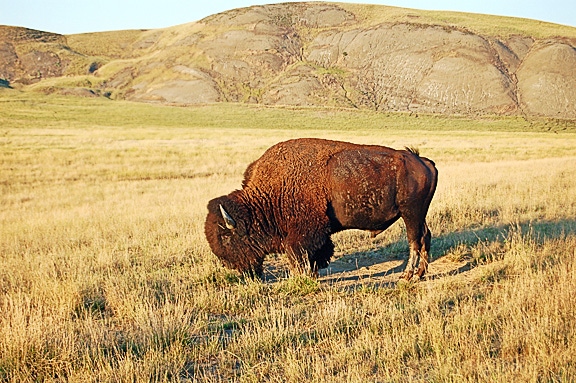Bison are not immune to this problem of E. coli contamination; after all, they are ruminants just like cattle.
July 23, 2019

You know about this, right? Northfork Bison Distributions, based in Quebec, Canada, announced July 17 that it was voluntarily recalling bison burgers after 21 persons in eight states fell ill. Most of the ill consumed bison burgers produced by Northfork and sold to retail outlets in the Eastern U.S.
Epidemiologic investigations revealed the illnesses were caused by E. coli 0121 and E. coli 0103 contaminated bison meat.
“Say it ain’t so, Joe.” There is a lot of history to go through and rehash to get to today’s dilemma for the bison industry.
First of all, there has been only one prior recall of bison meat for an E. coli contamination. That recall was for O157:H7, back in 2010.
I know the owner of the involved processing plant. In fact, I have seen the plant and visited with its owner. I doubt there are very many in the meat industry who preach and practice food safety more seriously than this man.
My meetings with the plant owner have been long ago, so I cannot provide a direct quote, but I do know that to this day he does not believe his plant was the source of contamination.
I also know that as a result of this recall, he built his own slaughter facility to have more control over what happens from start from finish.
If you know who I am talking about, fine, but I am not going to reopen old wounds by naming names. They are not important now that we have a second bison meat recall.
One we could sweep under the rug, but two is a different critter.
The second bit of history pertinent to this recall is the relatively recent naming of six E. coli strains, in addition to E. coli O157:H7, as adulterants in meat by the U.S. Department of Agriculture’s Food Safety & Inspection Service (FSIS).
These two strains, 0121 and 0103, are included in the six adulterants.
While I was Undersecretary for Food Safety at USDA, FSIS held its first public meeting in 2007, along with the Center of Disease Control (CDC) and Food & Drug Administration, regarding the non-O157:H7 Shiga Toxin producing E. coli strains, or STECs for short.
The support or resistance for change came from sources exactly as would be expected.
In 2010, for the first time ever, the six strains combined outnumbered O157:H7 for confirmed human illnesses, 451 to 442.
In 2011, CDC estimated that the six caused 1.08 infections per 100,000 citizens, compared to O157:H7 causing 0.98 infections per 100,000.
I think the numbers surprised many in the industry, and I also think that once epidemiologists and laboratorians began looking for, and testing for, the six non-O157:H7 STECs, it only makes sense that their numbers would rise.
The process to name these six non-O157 STECs as adulterants was probably enhanced by large, serious outbreaks in Japan and Germany; no reason to think it could not happen here too.
After a few starts and stops, FSIS finally announced that as of June 4, 2012, the six strains would be considered adulterants if found in “raw, non-intact beef products.”
You read that right; “non-intact beef products.” Not bison products.
Many know that bison were not included as amenable species in the Federal Meat Inspection Act of 1906 and therefore fall under FDA’s regulatory jurisdiction, so inspection is free. But individuals can apply for voluntary FSIS inspection and pay for it to qualify for certain trade practices like international sales.
Does voluntary inspection by FSIS make their product fall into the potential category of adulteration if the non-O15:H7 STECs are found?
Turns out that loophole has been closed and the regulations do apply to bison products, even if that involves liberal interpretation of the word “beef.”
I visited with Dave Carter, executive director of the National Bison Assn., about this question and the recall in general.
He said if the regulations said raw, non-intact bovine products, then that would clearly apply to bison products. He questioned how FSIS could consider bison meat to be beef.
Are you reading this FSIS?
He also advised me that in talking with his members, some were already spending upward of $600,000 per year testing for not just O157:H7, but for these six new non-O157:H7 strains that would be classified as adulterants if found in FSIS-inspected products.
I do not know if FDA would interpret the regulations the same way that FSIS does for the plants that fall under its jurisdiction, but I am guessing not.
I asked him how surprised or shocked he was that what may be a game changer for the bison industry, like Jack-in-the-Box was for beef, has suddenly created concerns about cooking temperatures for bison burgers, etc.
He responded that bison are not immune to this problem of E. coli contamination; after all, they are ruminants just like cattle.
But line speeds are slower, so the risk is lower, I guess.
Two closing thoughts:
The bison were slaughtered and further processed in Canada, but when the products crossed our border they became FSIS-inspected ground bison and all our regulations apply. Hence, it was adulterated meat, thus the recall in cooperation with the Canadian Food Inspection Agency.
Two days before the recall was announced I was having lunch with friends and the subject of food safety and cooking ground beef arose. Then it switched to ground bison. Sharing my “depth and breadth” of all things food safety, I advised them not to worry about ground bison cooking temperature, it was all safe
Could I please have a little egg on my face along with the bison burger in my hands?
About the Author(s)
You May Also Like


.png?width=300&auto=webp&quality=80&disable=upscale)
